Should Canucks give Reid Boucher another chance?
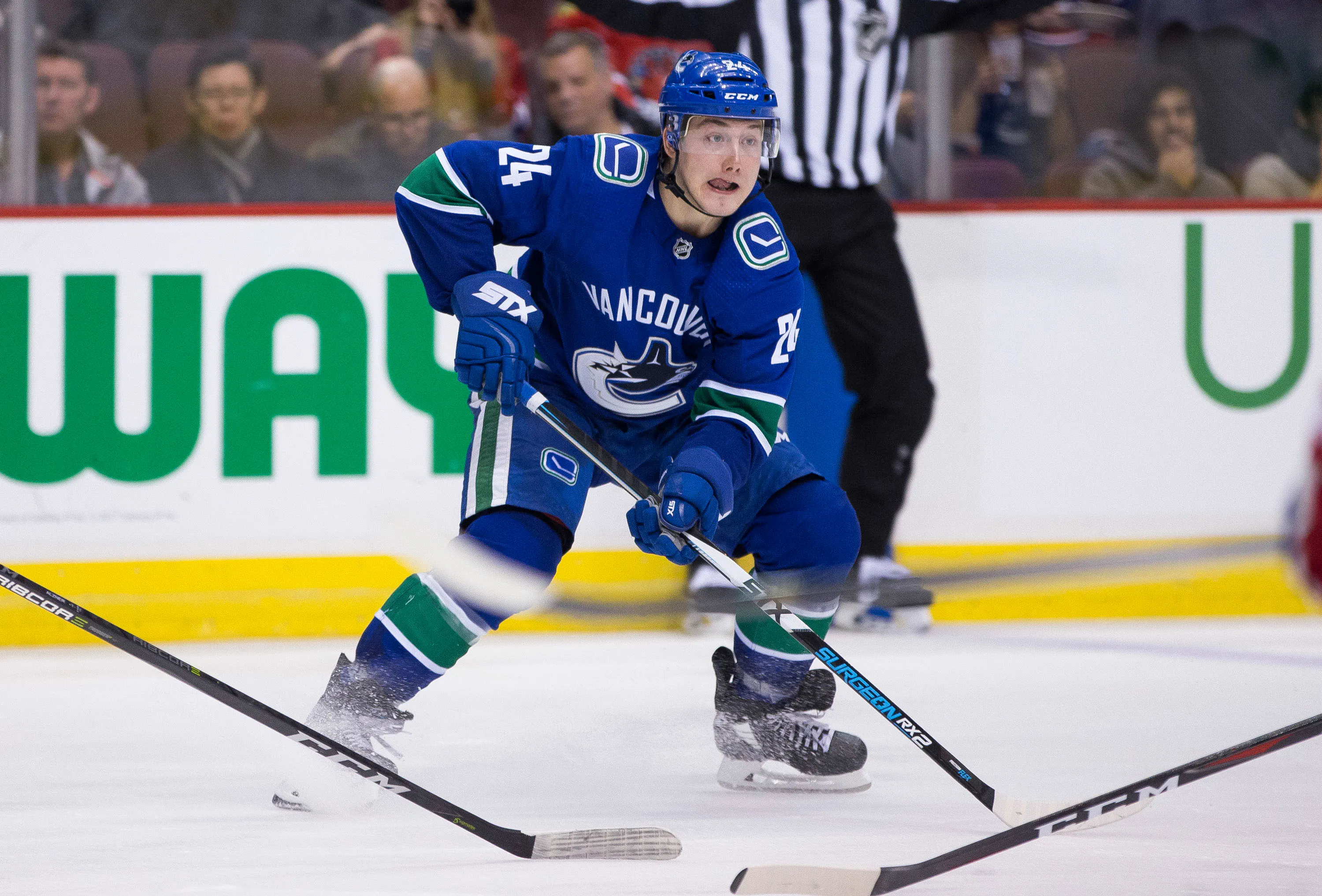
There are several things I imagined I might be when I grew up. An NHL hockey player. A powerful lawyer delivering a brilliant courtroom speech. Eddie Vedder. Alas, I was never a great skater, law school is too expensive, and I just never had rock star hair. But I have achieved something much greater. As anointed in a recent edition of Jason Botchford’s Athletties, I am Vancouver’s Leader on the Reid Boucher File.
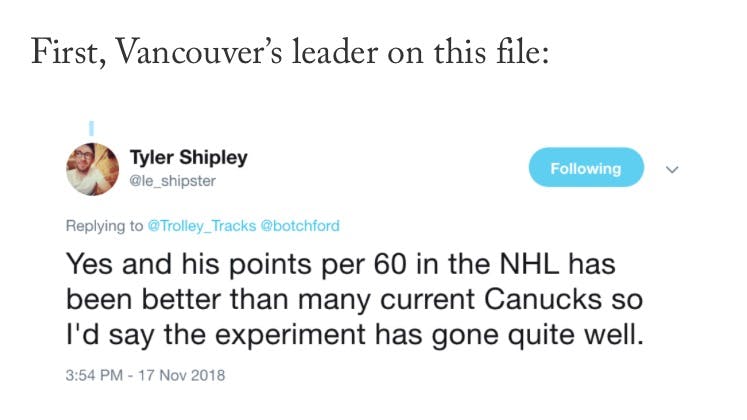
You’re probably wondering how I got here. Well, I’ve been watching the Canucks since the 1990s and I’ve been writing about hockey for nearly a decade in one form or another. This year, I have the honour of joining the ranks of Canucks Army, a blog that redefined Canucks fandom and analysis and shaped a lot of the ways I watch hockey. It’s a real pleasure to be here and to you, the readers, this is my introduction.
A Reid Boucher deep dive.
A Reid Boucher deep dive? Really?
Yep. This is my brand. If you aren’t going to love me at my “Reid Boucher Is Better Than You Think”iest than you don’t deserve me at my “I Know How To Fix The Draft Lottery”est. Given that the Canucks have just called up Sam Gagner – a player with a similar profile to Boucher – there’s never been a better time to make the case for Boucher. Below, I will illustrate that Boucher is an upgrade on Gagner, while being both cheaper and younger, and thus better suited to this stage in the Canucks rebuild.
A Reid Boucher Refresher
Boucher has been largely forgotten this year, given the understandable hype surrounding the arrival of Elias Pettersson, the emergence of a captain in Bo Horvat, and the stirrings of new life in Jake Virtanen. Starting the season in Utica, it appeared Boucher’s window for the NHL had passed.
Then he scored eight goals in about a minute and jumped out to a massive lead in AHL scoring. Had the Canucks missed something at camp? (Yes.) Were the expensive free agent signings keeping a goal-scoring machine out of a spot? (Yes.)
Alas, Boucher suffered an injury as a result of an illegal head shot by Syracuse Crunch forward Dennis Yan, for which he was suspended, and the wind was, again, out of Reid Boucher’s sails. It took several weeks for him to get back to game shape, but he is back now, and has picked up right where he left off. At this point, the 25-year old has scored 10 goals (15 points) in just 11 games in Utica. For the second season in a row, he appears to be among the very best players in the AHL. (Last year, he was good for more than a point per game and was named the club’s MVP while scoring in the AHL All-Star Game.)
Let me give you a moment to yell at your screens that Reid Boucher can’t skate, that he’s out of shape, and – my favourite – that he is a career AHL player who can’t translate his success at that level to the NHL. Go on, get it out of your system! You’ll feel better. Once you’ve done that, then we can move on to the next stage, where I patiently explain to you that those things are not correct.
Before I do that, let me put one thing on the table. I don’t want to overstate my case here: Reid Boucher is not going to move the needle on this team. Reid Boucher is not the difference between a last-place team and a playoff spot. Reid Boucher is not going to score 62 goals in a season, the way he did when he broke Steven Stamkos’ record for the OHL Sarnia Sting.
But I do believe that Reid Boucher can provide secondary scoring on an offensive-minded second- or third-line and the second powerplay unit, and that as the Canucks proceed in rebuilding this team, he could be a significant supporting piece. Teams that win Stanley Cups have three lines that can score, and while Boucher probably can’t drive a scoring line on his own, he could add a lot of value to one.
Let’s start by establishing a very important fact. Reid Boucher has had great success in the NHL.
Reid Boucher Is An NHL Player
I’m not entirely sure why no one seems willing to accept this, though I think a lot of it is a product of the stilted way in which he was introduced to the team and fanbase. Claimed on waivers in 2017 during the darkness of the Willie Desjardins era, he was given limited fourth-line ice, often spread out across several games of healthy scratches, and rarely had an opportunity to settle into any kind of rhythm. His tenure with the Canucks last season was often similar; it’s hard to expect much of a guy when he sits in the pressbox for a week and then gets only a handful of shifts with Nic Dowd (his most frequent linemate last season by a landslide).
And yet, despite playing primarily with Nic Dowd and a Jake Virtanen who really had not found his game, Reid Boucher put numbers on the boards.
Let’s take a serious look at his production in the NHL (keeping in mind that he has obliterated his competition in the AHL). The best way to assess his production is looking at his stats per 60 minutes, since he has had several games where he saw very little ice. Across his 132 NHL games, Boucher has produced at a rate of 1.54 points/60, and if you adjust to remove secondary assists he’s still at 1.25 primary points/60. How does that stack up with the rest of the Canucks’ forwards? It puts him ahead of most of the current crop of regulars.
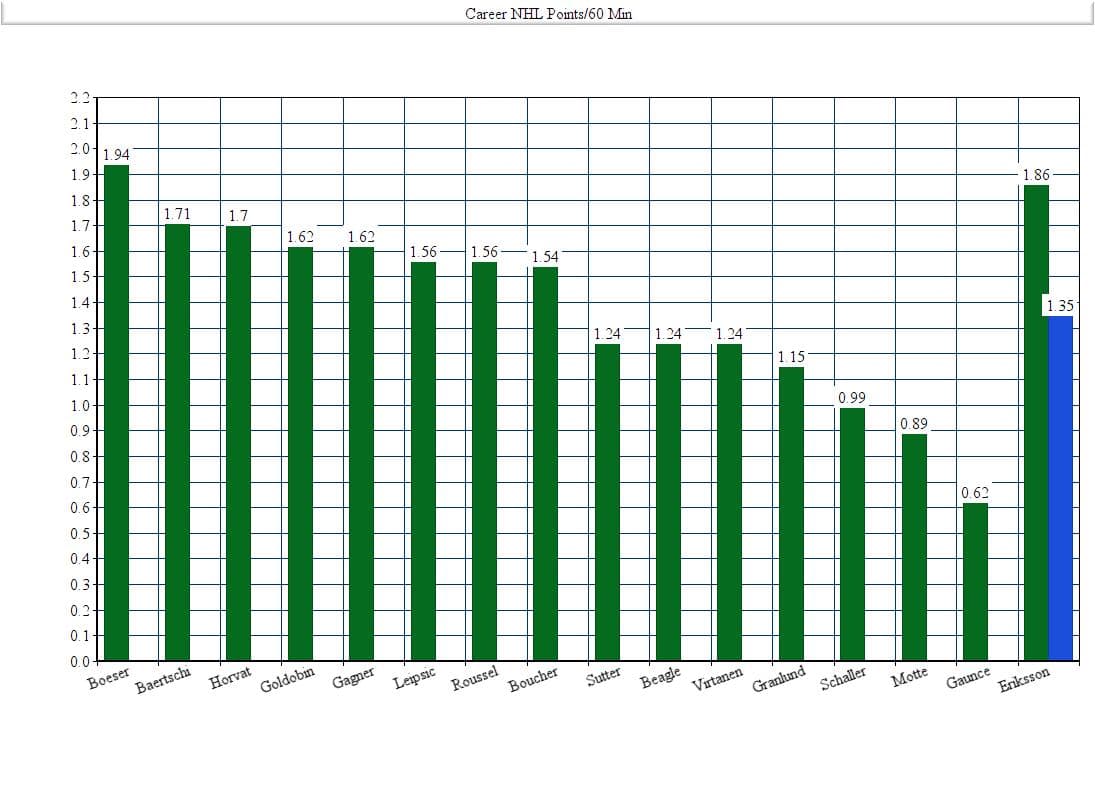
These are career averages, and I’ve removed Elias Pettersson and Darren Archibald, who each have less than 50 NHL games. Setting them aside, it’s no surprise that Brock Boeser, Sven Baertschi, Bo Horvat, and Nikolay Goldobin are higher than Boucher. No one is suggesting that Reid should take a spot from one of these players (or Pettersson) who are clearly the top offensive players on the team.
Loui Eriksson’s numbers are higher than some would expect (though the data is missing his first season) but this is largely a result of Loui’s much higher level of production in Dallas and Boston. If you look only at his time in Vancouver (the blue bar), his numbers drop to 1.35 / 1.05, putting him closer to Jake Virtanen’s level.
Boucher slots in with numbers comparable to Sam Gagner, Brendan Leipsic, and Antoine Roussel (whose underlying numbers always surprise and impress me, a point I’ll save for another day.) Though Sam’s star had fallen this season, this week he got the call ahead of Boucher. Notably, Gagner’s number’s drop off pretty hard when you remove secondary assists, in fact, Boucher actually contributes more goals and primary assists than Gagner. Meanwhile, Leipsic and Roussel, whose numbers are almost identical to Boucher’s, have both had regular NHL shifts this season when healthy. Below, I offer the same numbers but with secondary assists removed, as some consider those to be a bit weak.
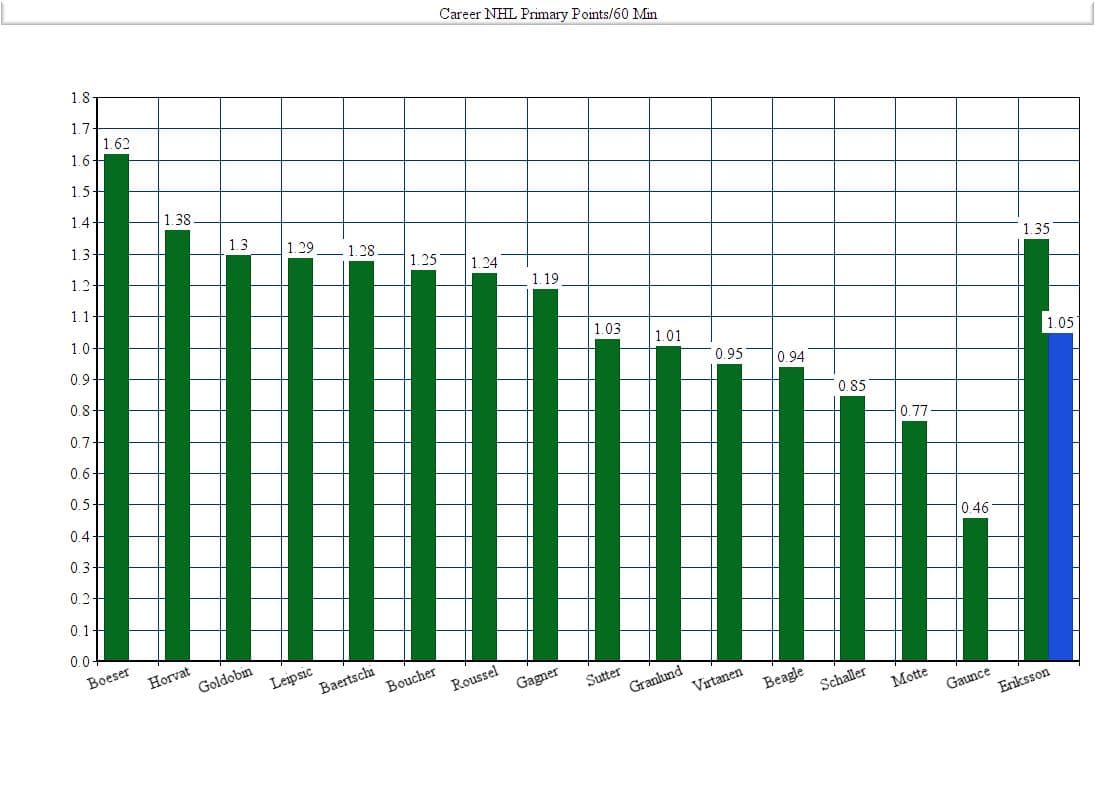
Reduced to just goals and primary assists, Boucher’s numbers look even more impressive – 7th on the team when you include Pettersson – and significantly better than many of the players he is directly competing with for a spot on the Canucks roster. Boucher has produced at a much higher rate than other wingers like Markus Granlund, Jake Virtanen, Tim Schaller, Tyler Motte, and Brendan Gaunce. There is an argument to be made that Jake is still trending upward – this especially seems true this season – and thus deserves his spot, which I accept. But the claim that Reid Boucher can’t translate his production to the NHL falls pretty flat when you consider how thoroughly he outproduces several players currently on the roster.
Take Your Shot
The book on Reid Boucher is that he has a nasty shot. Last season, several Canucks players commented on Boucher’s shot, and at least one called it the best on the team. He’s flashed that shot on several occasions and just plain beat NHL goaltenders with it.
Yeah that shot hit the back bar and perhaps the best thing about it was the fantastic reaction gif we got from Bruce Boudreau asking who, precisely, it was who had just scored.
Thanks for asking, Bruce. That would be Canucks future-20-goal-scorer Reid Boucher, who does indeed possess a dandy shot. A shot like that would sure look good on the second powerplay unit. But Boucher has a lot more to offer than just his shot. What many people seem unable to process is that he is also a good forechecker, who is quick and tenacious and can convert that forecheck into goals.
This is impressive puck recovery and, despite the delayed reaction in the video clip, that puck did indeed go in, buried on the wraparound. Boucher is a goal scorer and he has found a wide range of ways to do it. Also, if you’re the sort of monster who takes pleasure in seeing ankles getting broken, Reid can make a modest contribution:
I’m not going to put too much stress on your bandwidth by adding any more clips, but this is a guy who can beat an NHL goaltender clean with his wrist shot, can wire clappers from the spot on a powerplay, and has left a litany of undressed AHL defenders wondering what just happened in Utica. This guy can score goals. Do the Canucks need goals?
Penalty Differentials and Helping Your Team Win
Loui Eriksson has become famous this season for the ‘Little Things’ he supposedly does to help the Canucks win. I’m not here to debate the truth in that claim, but I do want to dig into a generally unreported ‘little thing’ that I think makes a big difference to a team’s success and tells you a lot about a player: drawing penalties.
Earlier this season, I was chatting with Canucks Army contributor and on-ice data-tracker Darryl Keeping about Boucher’s game, and we both noted that, when he did play, he seemed to draw a lot of penalties. It turns out, the numbers bear this out. Corsica Hockey tracks penalties taken and penalties drawn, and if we look at these also as a rate per 60 minutes, we get a clear picture of Boucher’s proficiency here. I’ve removed Antoine Roussel from the chart, because his ratings for both penalties drawn and taken are way above everyone else (2.30/2.64).
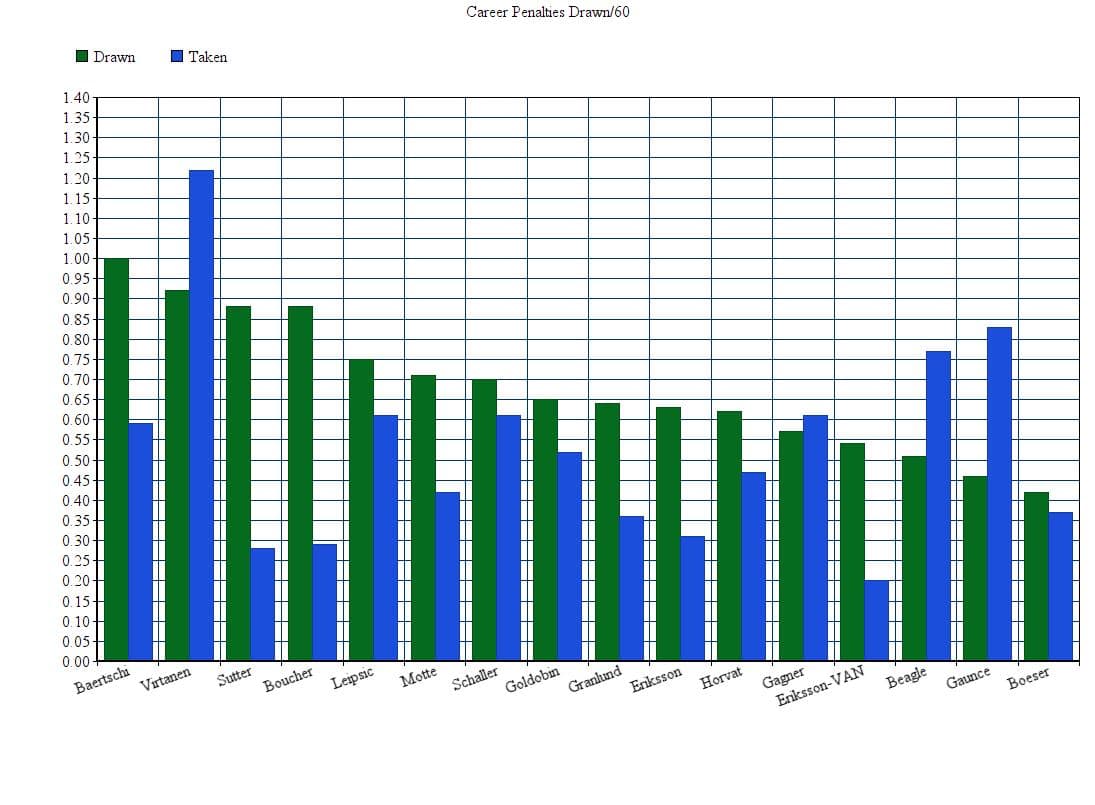
It always surprises me that this statistic doesn’t get more attention. We obsess over the strategy, personnel, and effectiveness of special teams, arguing for days over whether Pouliot should be playing the point on the powerplay or whether Bo is a good penalty killer. And yet, we rarely hone in on the particular skill of drawing penalties without taking them. On Saturday afternoon against Montreal, the Canucks were in a 2-2 tie in the dying minutes of the third period, when Michael Del Zotto took a ridiculous late run at Jesperi Kotkaniemi. Montreal got a powerplay and scored the winning goal. So don’t tell me this stuff doesn’t matter.
While some old school analysts still list penalty minutes as if it were a positive statistic, most people understand that if you take a lot of penalties you’re going to lose a lot of games. On the flip side, drawing penalties gives your best players an opportunity to make hay. A player who draws penalties is usually either an effective pest (looking at you, Antoine Roussel) or a player who can surprise opponents with speed, dexterity, and quick movements that force the opposition to hook, hold and otherwise illegally obstruct in order to prevent a scoring chance. This latter is where Boucher fits in.
Boucher is near the top of the current crop of Canucks at drawing penalties. While Roussel is way ahead, he takes more penalties than he draws, so he’s hurting his team as much as he is helping. Virtanen is in the same boat, drawing plenty but putting his team shorthanded just as often. Only Sven Baertschi and Brandon Sutter are helping their team as effectively in this regard as Reid Boucher.
Consider every 52 minutes of hockey he plays, Reid Boucher gives the Canucks an opportunity to line up Elias Petterson, Bo Horvat, and Brock Boeser on a powerplay. That’s nearly double what Brendan Gaunce will give you, and it is much better than recently recalled Sam Gagner who is more likely to take those skilled players off the ice by taking a penalty. Why not get Boucher out there drawing penalties so we can watch Elias go to work?
These numbers speak to that criticism of Boucher that I hear so often: that he is slow and out of shape. He’s really, really not. No one who watches him is saying this. Trent Cull, his coach in Utica this season and last, has regularly praised Boucher for not only the dramatic improvement in his foot speed, but also the completeness of his game. Cory Hergott, the resident Utica Comets expert at Canucks Army, has regularly reported on Boucher’s speed and quickness, but also his improved tenacity and physicality. There is plenty of video to illustrate this, but his strong record of drawing penalties is also a quantifiable way of illustrating this part of his game.
The Possession Game
Still not convinced? Ok, well, why don’t we look at one of the simplest and most effective ways of measuring a player’s effectiveness over a large sample of games. It is widely accepted that Corsi – a measurement of the number of shots directed at the opponent’s net while a player is on the ice, as opposed to the number of shots against – is among the best ways of quantifying puck possession.
The chart below uses Corsi-for %: if you have a high Corsi-for rating, it means your team has the puck more often when you are on the ice. Over a large sample, we can say with some certainly that a player with a strong Corsi-for rating is contributing to recovering picks, holding onto pucks, making effective passes, and keeping the puck in the opponent’s zone. These are all predictors of a team’s success. Put simply, if your Corsi-for is high, it means you are helping your team generate scoring chances and/or preventing the opponent from getting them.
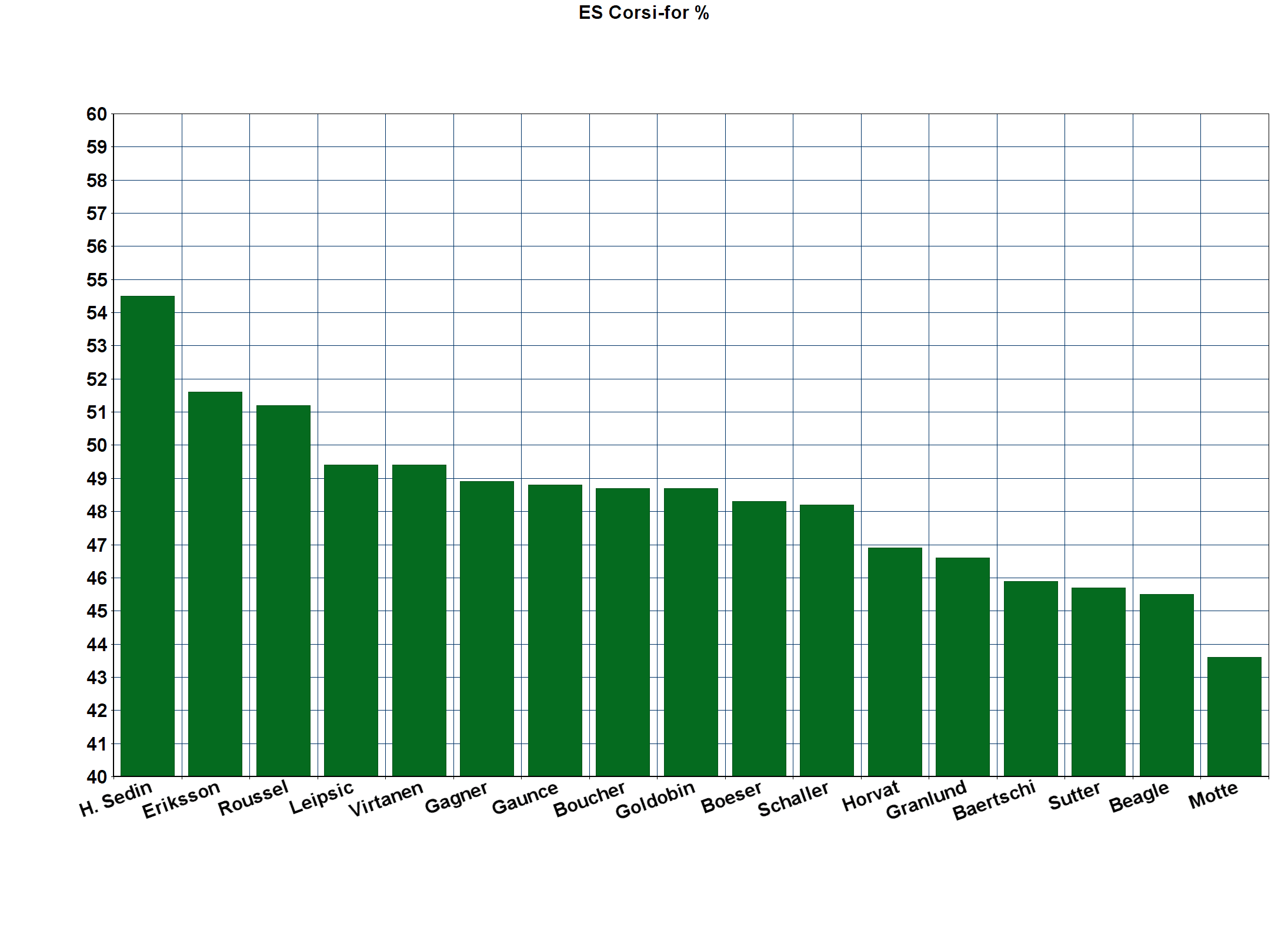
These numbers are only reflective of even-strength ice time, and as you can see, Reid Boucher’s Corsi rating is well within the average scores among the current crop of Canucks. For comparison’s sake, I added Henrik Sedin’s career Corsi-for rating, as both a reminder of how good Henrik was and also to provide a benchmark for the others listed here. These are career totals, and some (like Loui Eriksson) are trending down while some (like Brock Boeser) are likely going to trend upwards. Boucher’s respectable 48.7% illustrates that he is perfectly capable of playing in the NHL, that he isn’t a defensive liability, and – given a regular shift with the right linemates – I’m convinced he could push his rating even higher.
If by this point, the words “sample size” have crossed your mind, I want to remind you that Boucher has played 132 NHL games. It’s enough to take these numbers as some indication of his trajectory. But I also agree, it’s a sample size that needs to grow! So let’s get him up here and give him some time and space to find his game and excel, just as he has in the OHL, the AHL, and – as I have suggested here – in the NHL as well.
Boucher is an upgrade on several current Canucks, including Sam Gagner, while costing the team four times less than Gagner and producing at a higher rate in both the AHL and NHL. At just 25 years, he is still positioned to hit his stride alongside the emerging core. He is the kind of player a contender goes out and tries to find to bolster a third-line; if the Canucks can build a contender, they’ve already got a guy who can produce on that third-line.
Recent articles from Tyler Shipley





